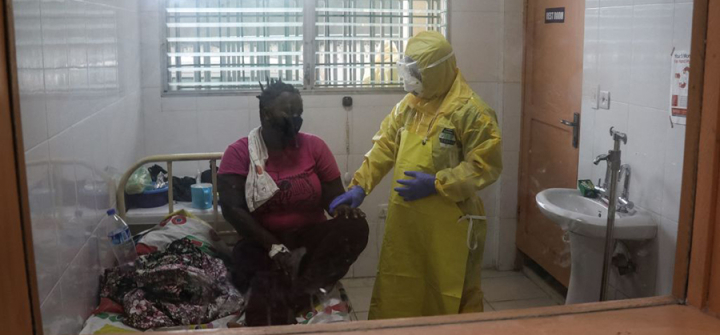Africa’s Third Wave Hits Liberia
Early in the pandemic, there were dire predictions about a tidal wave of COVID cases hitting sub-Saharan African, overwhelming already struggling health systems.
For much of the pandemic, those terrifying predictions didn’t materialize, perplexing researchers.
But a year in, that calculus is quickly changing across the continent.
In Liberia—after months of unused ICU beds and little sense of the virus’s presence—cases and deaths are quickly rising, explains Thelma Nelson, a Liberian physician and director of global health partnerships and grants at National Public Health Institute of Liberia, and co-lead of the country’s COVID-19 Response Case Management Pillar.
Currently on the frontlines of COVID-19, Nelson led Liberia’s rapid response team and supported the country’s infection prevention throughout the 2014-2016 Ebola crisis. She spoke to GHN for our latest COVID Countries dispatch.
Liberia:
5,396 cases
148 deaths
Source: Johns Hopkins University
Current situation/Big Picture:
Liberia is officially in the third wave of the pandemic, and we have instituted measures to put the current outbreak under control.
After months of cases going down, we found out in recent weeks that there is community transmission going on in Monrovia, as well as cases being brought in by travelers.
And with this new wave, patients are presenting with more severe symptoms
My belief is that until now, we didn’t really have a very virulent strain that would produce the kind of symptoms that we're now seeing.
Early in the pandemic, not more than 10% of cases presented with severe symptoms—now, about 80% of hospitalized cases are severe to critical.
Sequencing has now shown that the more contagious variant that originated in UK/ South Africa—now known as Beta—is actually in Liberia. Now we are sequencing more samples to see if we have any other variants circulating.
It’s often assumed that a lack of community-level testing accounted for Liberia’s low case numbers.
It’s true we haven’t had much community and voluntary testing—in recent months testing had focused primarily on travelers and their contacts. However, I think if there had been significant community transmission there would have been more cases popping up at health facilities—but that wasn't happening.
That is changing now, and I believe the rise of variants is driving this new wave of more severe cases.
Biggest Challenge
We have a lot of issues following cases among travelers, especially the asymptomatic ones who don’t believe their positive test results.
The deputy Health Minister in a recent press conference that there were 100+ plus positive cases that were lost to follow-up—they came into the country, and their addresses couldn’t be traced.
Testing is mandatory to enter the country, but for much of the pandemic we were using PCR testing at the airport, and test results would come in days after arrival.
While they wait for their results, people are advised to go home, follow all the preventive measures, including, wearing masks and frequent handing. But most people don’t follow the rules, and when the test results come back positive, many of the addresses and phone numbers are not correct. If you try to contact someone they might say, “Oh, this is my sister’s phone number and she's not around.” That has been one of the factors leading to community spread, people are just not cooperative.
However, the turnaround time for results have improved since the rapid tests became available at the airport. Hopefully this will address the issue of community spread from travelers.
Vaccine Situation
The first round of AstraZeneca vaccines was introduced in early May, coming from the COVAX facility.
To date, over 70,000 people have receive a single dose, in a country of almost 5 million. But less than 3,000 people have received their second doses.
The Johnson & Johnson vaccine should be arriving soon, solving the problem of people returning for a second dose.
In the next week or so there’ more vaccines coming in, but not nearly enough to vaccinate the whole population.
Mood of the People
Throughout the pandemic, many people believed that COVID wasn't even in Liberia, so people got complacent and weren't following the safety measures.
When vaccines arrived, there was a lot of resistance. There was a perception that it wasn't safe, even that it spreads COVID—particularly because its arrival has coincided with the third wave. Some people would say, ‘COVID is not even here, why should I be vaccinated for a disease that doesn’t even exist.”
Others said: ‘This vaccine hasn’t been thoroughly tested, I don’t want to make myself a lab rat for pharmaceutical company.’
In fact, the ones getting vaccinated initially were mainly expats working for the UN or NGOs, or people with the plans to travel.
But as public awareness grows, more Liberians started getting vaccinated—especially healthcare workers—and some organizations started to make vaccines mandatory for employees.
Since this new spike in cases, there has been a lot of interest in the vaccine—people are flooding in the vaccine centers—because they’re scared of the severity seen in this new wave.
Looking Ahead
COVID care in Liberia is free, so the government and partners are handling all the costs attached to that apart from some donors providing oxygen and medical supplies. But compared to the Ebola crisis, when the crisis was limited to West Africa, securing donor funding is far more challenging.
Our health care capacity isn’t where I want it to be, but at least it’s improving. For example, we were able to set up an infectious disease hospital specifically for COVID in the capital, Monrovia, with about 100 ICU beds.
That was set up early in the pandemic, but had been underused until this third wave. Now it’s close to full capacity.
The patients that we have are all severe-to-critical, on high flow oxygen, so oxygen tends to run out quickly, and all those tanks have to be refilled on a regular basis. It is important to maintain a steady supply of oxygen to support the treatment units, therefore there are plans to rehabilitate the available oxygen plants that are currently not functional.
However, we’re trying to make the best use of what we have.
Expectations vs. Reality
Many people are wondering, why hasn’t COVID spread widely in populated places like West Point, Liberia’s largest slum and a hotbed of the Ebola crisis.
I would say it’s a stroke of luck.
My best explanation that whatever strain we had before this must have been a little less virulent—and people may have had some sort of immunity to it.
Throughout the pandemic, we’ve had few cases in West Point, but it hadn’t spread widely and we never saw the severity we are starting to see now.
The biggest concern now is what will happen if a more dangerous variant actually starts to take hold in those very crowded areas?
What’s happening in your country? To be part of GHN’s COVID Countries series, email Brian at bsimpso1 [at] jhu.edu.
Join the 50,000+ subscribers in 170+ countries who rely on Global Health NOW summaries and exclusive articles for the latest public health news. Sign up for our free weekday enewsletter, and please share the link with friends and colleagues: https://www.globalhealthnow.org/subscribe
A nurse holds the hand of a patient in a COVID-19 ward of the Redemption hospital in Monrovia on July 1, 2021. Image: Emmanuel Tobey/AFP/Getty





